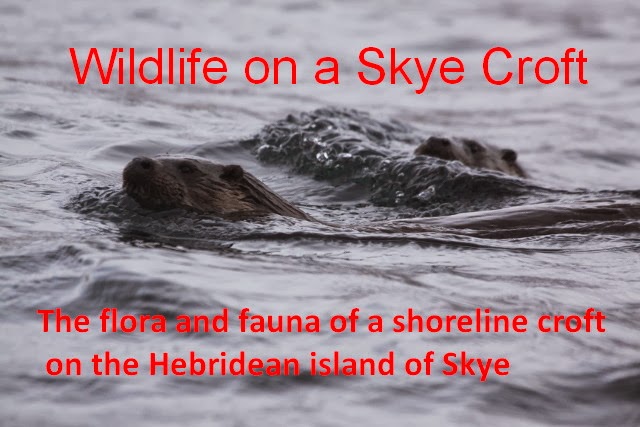Designated by the charity, Butterfly Conservation, last week was National Moth Night, oddly over 3 days. I don't think there were any events on Skye but in any case the theme this year was woodland, which is limited on the island. The weather was not great so I did not have my trap out but the previous week and this week, we have had several long sunny days with temperatures in the low to mid twenties. I had the trap out for the last two nights catching nothing remarkable; beautiful golden Y were commonplace, as were magpie moths. I had a poplar hawkmoth close to where there is a flowering greater butterfly orchid, a moth that is thought to be one of the pollinators, but there were no attached pollinia. Indeed despite setting up the trap close to the orchids several times in the last month I have yet to see the phenomena, so I am no wiser on the pollinators locally yet they do set seed. The moth counts over the last two nights have been modest, 31 and 39. I have been reading The Natural History of Moths by Mark Young, which I never got round to reading until now, which is a pity because I missed out inter alia on a useful summary about the success or otherwise of moth trapping. The count is influenced by:
- night-time temperature - warm nights are good;
- wind speed and direction - light south westerly wind is good;
- humidity - high is good;
- moonlight - low is good;
- high contrast with background is good;
- best if there are no other lights nearby;
- best if the trap is above ground level.
This week the night-time temperatures have been quite cool and there has been a full moon - hence, it seems, the modest counts.
 |
| Poplar Hawkmoth |
 |
| Magpie Moth |
 |
| Antler Moth |
 |
| Beautiful Golden Y |
The voles have relented a little. I have put netting around the runner beans, broccoli, and to limit bird attack also, a nice showing of peas. Intended for voles, I caught a water shrew in the mammal trap yesterday morning. Unmistakeable, it is slightly larger than the common shrew (though not much help if they are not side by side for comparison), with a dark brown - slatey grey coat, and near white on the underside. There is no transition between the two colours. Addition of the water shrew brings to 15 the number of mammals we have seen either on the croft or offshore. Surprisingly we have not seen hedgehogs, nor, fortunately, rabbits. There are no otters or deer around at the moment, and here are also very few seabirds about except for the occasional gannet.
 |
| Water Shrew |
Earlier this week I went on a Skye Botany Group walk up to the cliffs under Sgurr a'Mhadaidh Ruadh on the Trotternish ridge. SBG is an informal group led by the county recorder, Stephen Bungard, who blogs regularly and comprehensively about the plants of Skye (http://skyeraasayplants.wordpress.com/). If the group were more formal then I doubt I would qualify because my botanical knowledge beyond a couple of plant families is very limited (to compensate I offered to drive!)
Trotternish is one of my favourite places. Geologically it is very interesting, an escarpment where gently sloping jurassic sedimentary rocks are overlain by more recent lavas and intruded by dolerite, the weight of which on the softer sedimentary rocks caused land slips over millions of years to leave steep east facing cliffs. The views are dramatic. It also has some uncommon and indeed rare alpine plants growing on the crumbly wet basalt-like ledges. Stephen has commented that we saw 6 saxifrages within perhaps 100 yards of each other which is quite remarkable given that there are only 11 species native to Great Britain (excluding Ireland). The rarest plant, Tufted Saxifrage was past flowering, and the other scarce plant, Alpine Saxifrage was a little past its best. An end June walk next year is definitely on the list to see both fully flowering.
 |
| Trotternish |
 |
| Yellow Saxifrage |
 |
| Mossy Saxifrage |
 |
| Tufted Saxifrage |
 |
| Alpine Saxifrage |
 |
| Basalt -like Ledges |
On top of the ridge we saw Iceland Purslane which grows on Trotternish and Mull but nowhere else in Britain. A truly arctic plant, a few years ago I saw it growing in profusion amongst gravels on Svalbard, 1,300 miles further north. On Trotternish the plants are tiny, and I have yet to see one fully open.
 |
| Iceland Purslane |
An excellent excursion!












